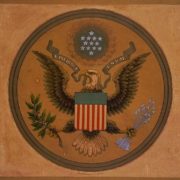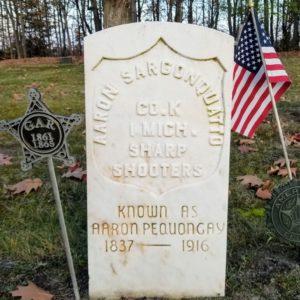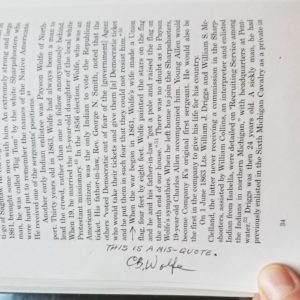At Hillcrest Cemetery in Omena one can see the grave of Civil War veteran Aaron Pequongay who was a member of Company K of the First Regiment of Michigan Sharpshooters, a mostly Native American Co. He was born near Whitehall, Michigan in 1837 and was living in Omena in 1865. He enlisted on Feb 14, 1865 at the age of 21 and was discharged later that year on August 11 because the war had ended. His gravestone reads Aaron Sargonquato, which seems to be a misspelling of Sahgahnahquato, the name he used when he enlisted. Why the different names? We will likely never know. That seems to be one of the details lost in time or translation and just one of the interesting things about his story.
Payson Wolfe, also a Native American and from Northport was well liked and a natural leader. Payson was one of the first men to enlist in Company K when it was founded in 1863. Then in late 1864 Payson was furloughed at home in Northport to recover from being held prisoner at Andersonville; the notorious prison in Georgia that had the highest mortality rate of all Civil War era prisons. Upon his recovery he returned to active service and he brought three new recruits with him, all from Northport, Aaron Pequongay age 21, John Jacko and John Kiniewahasoipi, both aged 20.
![This is one of the few photos that exists of Native American soldiers from the civil war exist. These are wounded men after the Battle of the Wilderness (Fredericksburg, Virginia. Wounded Indians from the Wilderness on Marye's Heights. United States, 1864. [or 20] Photograph. https://www.loc.gov/item/2018670667/.)](https://www.omenahistoricalsociety.org/wp-content/uploads/2020/11/Fredericksburg-Virginia-Wounded-Indians-from-the-Wilderness-on-Maryes-Heights-300x300.jpg)
This is one of the few photos that exists of Native American soldiers from the civil war. These are wounded men after the Battle of the Wilderness (Fredericksburg, Virginia. Wounded Indians from the Wilderness on Marye’s Heights. United States, 1864 https://www.loc.gov/item/2018670667/.)
]What conversations occurred that winter that resulted in those three young men deciding to join up at that time? Payson must have been persuasive to recruit three more men, in February, to join the Civil War already in progress for four years and knowing of the terrible casualties. There was some thinking at that time among Native Americans that joining the US in fighting in their war could possibly help promote your standing and avoid being relocated by the U.S. government, the urge to stay in Michigan was strong. There might have been some fear that if the Confederates won they could possibly try to enslave Native Americans too. The financial gains of monthly pay and bounties to enlist could have also been reasons to enlist, poverty was a fact of life. Native Americans could not be drafted at that time as they were not citizens, but they could enlist.
Company K was formed in 1863 and was planned to be a mostly ‘Indian company’ all recruited from Michigan.There had been efforts to form such a company earlier at the start of the war in 1861 but it was dismissed by the U.S. as undesirable for a variety of reasons, mostly based on prejudice and considering that it had not been that long since those same people had been involved in warfare with the U.S. But by 1863 the U.S. had suffered so many casualties that they went back and formed Indian and more black companies in desperation for more men. As a point of context it is important to note that the ‘Indian wars’ were already happening in the western U.S.
Payson took Aaron, John J. and John K. to Grand Rapids in mid-February in 1865 to be mustered into Company K. From there they took a train to Petersburg, Virginia. It seems they spent their service time in and around Petersburg during the siege on that city. Payson and Aaron survived the war. John Kiniewahasoipi died on March 5 from disease just shortly after arriving in Petersburg and it is not clear what happened to John Jacko.
After the war Aaron returned to Northport and his wife Susan Allen Pequongay (1852-1939). Where they had children and then grandchildren and even great-grandchildren. Aaron died of heart disease in 1916 and is buried in Omena as mentioned above. His wife Susan was the last surviving widow of a Michigan Ottawa Indian who served in the Civil War. In her own right she was a celebrated maker of traditional Anishinaabe baskets and a leader of her people. Some pictures and her obituary can be viewed here.
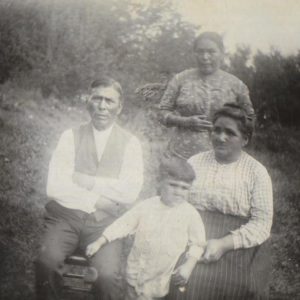
Aaron & Susan Pequongay seated, standing in back is likely their daughter Julia King and the child in front is likely their grandson Perry King.
A book about the Michigan Sharpshooter regiment called, “These Men Have Seen Hard Service” by Raymond Herek was very helpful in writing this post and copy is available at the Leelanau Township Library. It was donated to the library by Payson Wolfe’s great-grandson Clarence “Bud” Burnside Wolfe. Also of note is a news story called “The story of Company K: Native Americans from Michigan who saw tough action in the Civil War” by Michigan Public Radio. You can listen to it here.
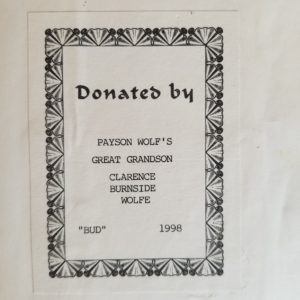
Payson Wolfe donated “These Men have Seen Hard Service” to the Leelanau Township Library. This is the book plate.
Historic research always finds as many new questions as it answers! How/why did Aaron get from Whitehall to Northport? What type of action did he see during the Civil War? What was life like for Aaron and Susan after the war? Susan Allen Pequongay is also buried at the Omena Hillcrest cemetery. If you have any information to share about any of the veterans in this story or any veterans with a connection to Omena please contact us at OmenaVeterans@gmail.com as we are actively collecting new information about Veterans with a connection to Omena. Thank you.

